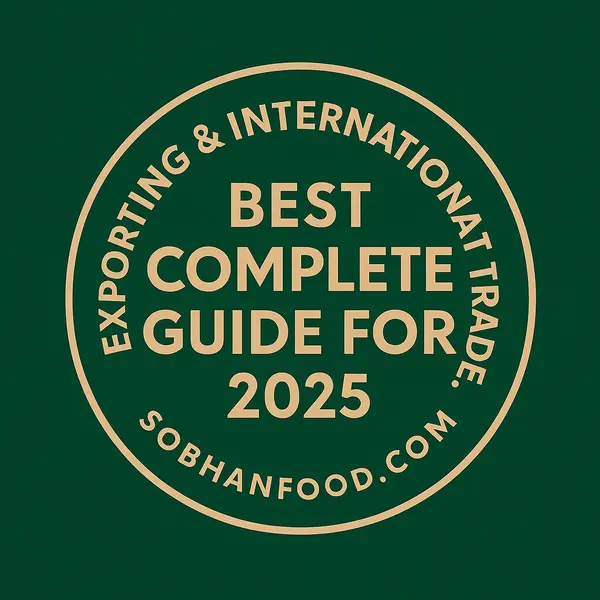Introduction
Global trade has shaped human civilization for centuries, from the Silk Road to today’s digital marketplaces. In 2025, exporting is no longer reserved for large corporations — small and medium-sized enterprises (SMEs), including food manufacturers, have unprecedented opportunities to expand globally.
Exporting isn’t just about moving products across borders. It’s about building relationships, adapting to international standards, and using smart strategies to compete in the global marketplace. For companies like Sobhan Food, which operates in the food industry, exporting offers opportunities to introduce products to international consumers, diversify revenue streams, and strengthen brand reputation.
This article provides a comprehensive guide to exporting and trade, tailored for businesses looking to succeed in 2025.
What is Exporting?
Exporting refers to the sale of goods and services produced in one country to buyers in another. It is the foundation of global trade and one of the easiest entry strategies for businesses going international.
Types of Exporting
-
Direct Exporting
-
Selling directly to customers or distributors in the target country.
-
Advantage: Higher margins and better control over branding.
-
Example: A food producer exporting directly to supermarket chains in Europe.
-
-
Indirect Exporting
-
Selling through intermediaries such as export management companies or local distributors.
-
Advantage: Easier entry into foreign markets with less risk.
-
Example: Partnering with a trading house that handles logistics and compliance.
-
Why Exporting Matters in Today’s Economy
Exporting is no longer optional — it’s a necessity for growth.
-
Revenue Growth: Access to millions of new consumers abroad.
-
Market Diversification: Reduces dependence on a single local market.
-
Brand Recognition: International exposure increases credibility.
-
Innovation Driver: Competing globally pushes businesses to improve quality.
-
Employment & GDP Growth: Exporting industries support national economies.
💡 Example: Iran’s food industry exports — from saffron to nuts — play a significant role in GDP contribution and global cultural branding.
Global Trade Trends in 2025
International trade is changing fast. Key trends shaping the export market include:
1. Digitalization of Exporting
-
E-commerce platforms like Alibaba, Amazon Global, and B2B marketplaces make exports accessible to SMEs.
-
Blockchain technology ensures secure and transparent transactions.
2. Sustainability & Green Exports
-
Consumers demand eco-friendly packaging, sustainable sourcing, and organic certifications.
-
Carbon-neutral shipping is becoming standard practice.
3. Regional Trade Agreements
-
Free Trade Agreements (FTAs) between countries reduce tariffs and simplify customs.
-
Example: Regional Comprehensive Economic Partnership (RCEP) in Asia.
4. Shifting Consumer Demands
-
Growing middle classes in Asia and Africa increase demand for high-quality imported food.
-
Halal, organic, and gluten-free certifications are highly valued.
5. Technology-Driven Logistics
-
AI-driven supply chains predict demand and reduce costs.
-
Smart tracking systems improve transparency.
Challenges in Exporting
Despite the opportunities, exporters face obstacles.
-
Complex Regulations – Each country has unique rules on packaging, labeling, and certifications.
-
Customs Procedures – Delays at borders can hurt supply chains.
-
Payment Risks – Dealing with international buyers may involve currency risks and defaults.
-
Logistics Costs – Freight rates, insurance, and warehousing expenses.
-
Cultural Differences – Misunderstanding business etiquette can damage negotiations.
-
Political Risks – Sanctions, tariffs, or sudden restrictions.
💡 Tip: Mitigate risks by working with freight forwarders and using secure payment methods like letters of credit.
Step-by-Step Exporting Process
1. Market Research
-
Identify high-demand countries.
-
Use tools like ITC Trade Map, Google Trends, or local chambers of commerce.
2. Product Adaptation
-
Modify packaging to meet foreign regulations (nutrition labels, halal, organic certifications).
-
Adapt taste to local preferences if necessary.
3. Finding Buyers
-
Use online B2B platforms.
-
Attend international food expos (e.g., Gulfood Dubai, Anuga Germany).
-
Partner with local distributors.
4. Pricing Strategy
-
Consider production costs, tariffs, shipping, and competitor pricing.
-
Use Incoterms (FOB, CIF, EXW) to clearly define responsibilities.
5. Documentation & Compliance
Export documents include:
-
Commercial Invoice
-
Packing List
-
Bill of Lading / Airway Bill
-
Certificate of Origin
-
Health & Safety Certificates (for food exports)
6. Logistics & Shipping
-
Choose between air, sea, or land transport based on product type.
-
Use cold-chain logistics for perishable goods.
7. Payment & Finance
-
Payment Methods: Advance payment, letters of credit, open account.
-
Financing Options: Export credit agencies, government-backed export loans.
Exporting in the Food Industry (Sobhan Food Example)
Food is one of the most traded commodities globally. For companies like Sobhan Food, specializing in food production, exporting offers a powerful growth opportunity.
Top Export Markets for Food in 2025
-
Middle East – High demand for packaged and halal-certified food.
-
Europe – Organic and sustainable food products are popular.
-
Asia – Growing middle class and demand for healthy snacks.
-
North America – Specialty foods and ethnic cuisines are trending.
Compliance for Food Exports
-
Halal Certification – Essential for Middle Eastern markets.
-
Organic Certification – Needed for EU and US markets.
-
ISO 22000 / HACCP – Food safety management standards.
-
Labeling Regulations – Must include nutrition facts, allergens, and expiry dates.
Marketing Food Exports
-
Highlight “Made in Iran” heritage and quality.
-
Use storytelling (authentic recipes, traditional flavors).
-
Leverage digital marketing for global awareness.
Regulations & International Compliance
Compliance is the backbone of successful exporting.
-
WTO Rules – Ensure fair global trade practices.
-
Export Control Laws – Check sanctions and restrictions.
-
Trade Agreements – Utilize lower tariffs via FTAs.
-
Customs Requirements – Ensure HS codes and paperwork are accurate.
Strategies for Successful Exporting in 2025
-
Adopt E-Commerce Exporting – Sell directly through platforms.
-
Use Digital Marketing – SEO, multilingual websites, social media targeting foreign audiences.
-
Build International Partnerships – Agents, distributors, joint ventures.
-
Leverage Government Support – Export promotion councils, trade missions.
-
Focus on Branding – International buyers prefer strong, reliable brands.
💡 Case Study: Turkish food companies expanded exports by branding themselves around quality and heritage. Sobhan Food can follow a similar path.
Future Outlook for Exporting
By 2030, global trade is expected to grow by 30%, driven by emerging markets and digital platforms. Food exports, in particular, will see steady growth due to rising populations and dietary diversification.
-
AI-Powered Trade: Predicting consumer demand with data.
-
Blockchain Finance: Secure transactions and transparent supply chains.
-
Sustainable Practices: Eco-friendly logistics becoming mandatory.
-
Personalized Exports: Adapting products to niche consumer needs.
Conclusion
Exporting and trade are the lifelines of the global economy. For businesses in the food industry, like Sobhan Food, the opportunities are immense — but only if approached strategically. By understanding regulations, adopting digital tools, and focusing on quality and branding, exporters can thrive in 2025 and beyond.




